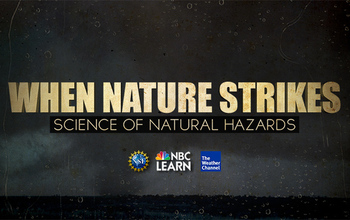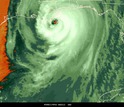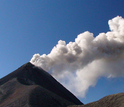News Release 15-119
NSF, NBC Learn and The Weather Channel showcase research to protect against nature's fury
Participate in Twitter chat #NatrlHazards to learn more

NSF Geosciences, NBC Learn and the Weather Channel present a 10-part series on natural disasters.
September 29, 2015
This material is available primarily for archival purposes. Telephone numbers or other contact information may be out of date; please see current contact information at media contacts.
The National Science Foundation (NSF) Directorate for Geosciences, The Weather Channel and NBC Learn today released an original video series that explores the science of natural disasters to avert their human and economic toll. The 10-part series, "When Nature Strikes: Science of Natural Hazards," spotlights fundamental scientific research that NSF funds to improve predictability and risk assessment that will reduce impacts from catastrophic events.
Superstorm Sandy, Hurricane Katrina, California wildfires, earthquakes, tornadoes, tsunamis--natural disasters are devastating and costly. Thousands of human lives and tremendous amounts of property are lost annually. In 2013 alone, such events killed some 20,000 people and caused over $130 billion in damage worldwide.
"Our nation has become increasingly vulnerable to natural disasters," said NSF Assistant Director for Geosciences Roger Wakimoto, "Important research to improve our understanding of these hazards will lead to improved forecasts and warnings that will save lives and help mitigate the impact on society and the economy."
Soraya Gage, vice president and general manager of NBC Learn, touted the value of working with NSF.
"Our partnership with the National Science Foundation has provided a great platform for showcasing the latest research on natural disasters through original video content," she said. "'When Nature Strikes' breaks down the science behind natural disasters through powerful storytelling and captivating video."
The series, narrated by The Weather Channel's Marshall Shepherd, a professor of meteorology at the University of Georgia and host of the program Weather Geeks, will air on The Weather Channel, NBC affiliate stations, and can also be viewed (free of charge) online at NBCLearn.com, NSF.gov and Science360.gov.
From these videos, viewers will learn about a variety of natural disasters and the tools and resources that can reduce loss of life and damage to infrastructure and the environment. NSF-funded experts from around the country are featured in each segment.
A list of the segments follows:
1. Overview - "When Natures Strikes: the Science of Natural Hazards," a series that showcases research teams supported by NSF's Directorate for Geosciences, explores natural hazards, how they form, where they appear and when they strike.
2. Earthquakes - John Vidale, a University of Washington seismologist and director of the Pacific Northwest Seismic Network, is leading a team of scientists monitoring ground motion across Washington and Oregon to prepare residents for the next, magnitude 9 "megathrust" earthquake to hit their region.
3. Volcanoes - Michael Manga, a University of California Berkeley geologist, studies the explosive Armageddon-like eruption at Long Valley Caldera some 50 years ago for insights on supervolcanoes today.
4. Hurricanes - Jenni-Louise Evans of Pennsylvania State University and Jeff Donnelly of Woods Hole Oceanographic Institution, Woods Hole, Massachusetts, explore nature's most violent natural disasters, hurricanes--how they form and what factors influence where and when they make landfall.
5. Flash Floods - Russ Schumacher, an atmospheric scientist at Colorado State University, studies areas with combined factors such as heavy precipitation, particular geography and soil conditions that put them at risk for flash floods, one of the most common and deadly natural disasters.
6. Landslides - Falling rocks, giant walls of mud and landslides past and present inform research by David Montgomery, a professor of geomorphology at the University of Washington. Montgomery works to unravel how and why landslides happen.
7. Tornadoes - Tornadoes form in minutes. Howard Bluestein of the School of Meteorology at the University of Oklahoma and Adam Houston of the University of Nebraska-Lincoln study why some storms result in tornadoes while others do not. With advanced warning, people can prepare and lives will be saved.
8. Space Weather - Space weather has the potential to wreak havoc on everything from satellite communications to electricity. Sarah Gibson, an astrophysicist at the National Center for Atmospheric Research (NCAR) in Boulder, Colorado, examines space weather, which has all sorts of natural disaster implications on our planet.
9. Wildfires - With just one lightning strike, a wildfire can ignite and burn thousands of acres of land, devastate communities and claim lives. Janice Coen, with the National Center for Atmospheric Research (NCAR) in Boulder, Colorado, is working on how to predict wildfire behavior.
10. Tsunamis - The massive wave of a tsunami can form thousands of miles offshore and then travel quickly across an ocean to devastate coastal communities. Anne Trehu and Dan Cox of Oregon State University are studying how tsunamis are formed and how to survive them.
Use #NatrlHazards and participate in a Twitter chat, hosted by NSF and NBC Learn Thursday, Oct. 1, at 6 p.m. EDT. This discussion will feature The Weather Channel's Marshall Shepherd (@DrShepherd2013) and other scientific experts seen in the series: Jenni Evans (@JenniLEvans), Russ Schumacher (@russ_schumacher) and Adam Houston (@ahous). Join us!
About NBC Learn
NBC Learn is the educational arm of NBC News, with some 200 local affiliates, dedicated to providing resources for students, teachers and lifelong learners. The online resources NBC Learn has created for the education community leverage nearly 80 years of historic news coverage, documentary materials and current news broadcasts. NBC Learn comes in two versions, "NBC LEARN K-12" and "NBC LEARN Higher Ed" and is available to librarians, media specialists, educators, students and parents. The resource gives students and teachers access to thousands of video clips from NBC News archives, including great historic moments -- from the Great Depression to the Space Race to the latest political coverage. NBC Learn also offers primary source materials, lesson plans and classroom planning resources, and additional text and image resources.
-NSF-
-
Jeff Weber at UCAR generated an image of Hurricane Katrina using GEMPAK software and NOAA data.
Credit and Larger Version -
Fuego, an open-vent volcano located 20 miles west of Guatemala City, erupts in a small explosion.
Credit and Larger Version -
NCAR scientists are studying wildfires in order to forecast fire-weather interactions.
Credit and Larger Version
Media Contacts
Lisa-Joy Zgorski, NSF, (703) 292-8311, email: lisajoy@nsf.gov
Hollie Tracz, NBCUniversal News Group, (212) 664-3114, email: hollie.tracz@nbcuni.com
The U.S. National Science Foundation propels the nation forward by advancing fundamental research in all fields of science and engineering. NSF supports research and people by providing facilities, instruments and funding to support their ingenuity and sustain the U.S. as a global leader in research and innovation. With a fiscal year 2023 budget of $9.5 billion, NSF funds reach all 50 states through grants to nearly 2,000 colleges, universities and institutions. Each year, NSF receives more than 40,000 competitive proposals and makes about 11,000 new awards. Those awards include support for cooperative research with industry, Arctic and Antarctic research and operations, and U.S. participation in international scientific efforts.
Connect with us online
NSF website: nsf.gov
NSF News: nsf.gov/news
For News Media: nsf.gov/news/newsroom
Statistics: nsf.gov/statistics/
Awards database: nsf.gov/awardsearch/
Follow us on social
Twitter: twitter.com/NSF
Facebook: facebook.com/US.NSF
Instagram: instagram.com/nsfgov



